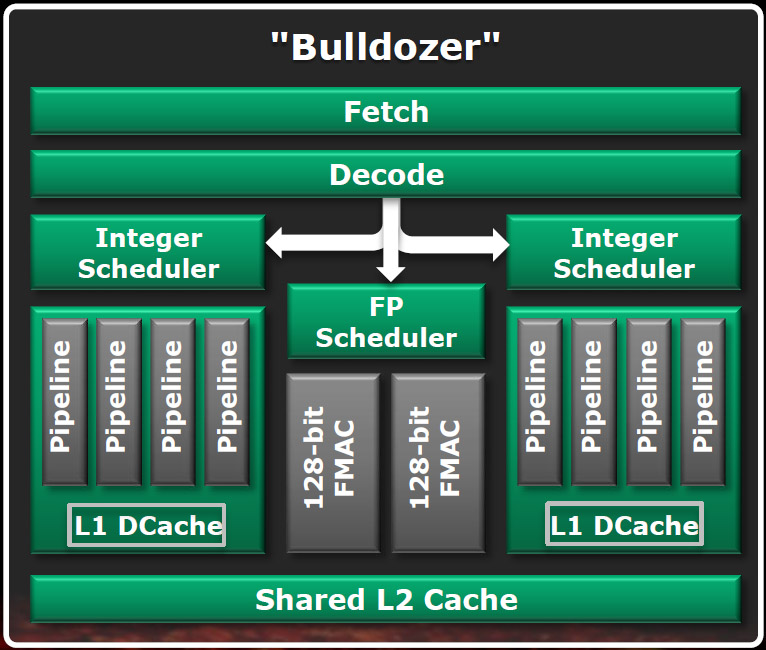Judge Allows Lawsuit Over AMD's FX Processors to Continue
U.S. district judge Haywood Gilliam has allowed the class-action lawsuit alleging that AMD misled its customers about the number of cores in its FX CPUs to continue. According to the lawsuit, which was filed in 2015, the shared cores utilized by the FX processor line's Bulldozer modules shouldn't have been counted individually.
We explored the Bulldozer concept when we reviewed the FX-8150 back in 2011. AMD had previously taken a bit of a holier-than-thou approach to counting cores because it believed Intel's Hyper-Threading, which offers two logic processors for each physical core, was disingenuous. But then AMD developed the Bulldozer module to share "instruction fetch and decode stages, floating-point units, and the L2 cache" between two cores and changed its tune.
This is where the lawsuit comes in. Some people who bought the FX-8120, FX-8150, FX-8320, FX8350, FX-8370, FX-9370, and FX-9590 processors believe AMD misled them with its claims about how many cores the processors had. The company marketed its FX processors as the world's first eight-core CPUs, but because of the shared resources between cores in Bulldozer modules, the lawsuit alleges that this claim was deceptive about real-world performance.
We pointed out nearly a decade ago that AMD had suddenly changed its definition of what a "core" is for these processors:
"To best accommodate its Bulldozer module, the company is saying that anything with its own integer execution pipelines qualifies as a core (no surprise there, right?), if only because most processor workloads emphasize integer math. I don’t personally have any problem with that definition, but if sharing resources negatively impacts per-cycle performance, then AMD necessarily has to lean on higher clocks or a greater emphasis on threading to compensate."
AMD's goal for Bulldozer modules was to offer many of the benefits of having a bunch of cores without actually having to, you know, use completely separate cores. The company said at the time that a Bulldozer module could average 80% the performance of two complete cores. But the lawsuit's plaintiffs weren't looking for eight-core processors that performed like six-core processors; they wanted the performance of eight individual cores.
Gilliam decided in January 2019 to reject AMD's request to dismiss the lawsuit because several of the plaintiffs (allegedly) knew exactly how its Bulldozer module worked prior to purchasing the processors. This isn't an outright victory for the plaintiffs--Gilliam is merely allowing the lawsuit to proceed--but it does mean AMD can't just steamroll the lawsuit out of the court. Everyone heads back to court on February 5 to discuss the case.
Get Tom's Hardware's best news and in-depth reviews, straight to your inbox.

Nathaniel Mott is a freelance news and features writer for Tom's Hardware US, covering breaking news, security, and the silliest aspects of the tech industry.
-
jimmysmitty Reply21705175 said:Well they dis mislead the consumer! :pfff:
I mean technically they are 8 core CPUs. They just share resources which make them slower than other 8 core CPUs in some tasks.
However what needs to be defined is the "core". What constitutes a core? They keep changing. Cores used to be the more basic part with L2 cache being an add-on part you could buy. After a while the L2 cache was integrated into the core and thus became part of the core and ever since most CPUs have separate L1 and L2 cache per core.
So I guess what will really happen is they will have to define what makes up a core and if it fits then its thrown out. If it doesn't I could see AMD losing the case. I really think AMD should have just called it something like Advanced Hyperthreading as the reality is that is what it was. -
Dark Lord of Tech But AMD wanted to get a step ahead , so they went forward with their own core definition.Reply -
lastguytom If the lawsuit goes thru with a loss for AMD. I IS SEE OTHERS putting a claim in. I think this is another way to either have AMD loose money, or the guy who decided to do the lawsuit is either a stock holder upset over his stock, since the release of Ryzen, or its another INTEL Athlon day ploy HE WAS PUT UP TO.Reply -
lastguytom The bulldozer design was stated before it was on sale, it was a tech site saying it was not 8 cores base on how INTEL CPU cores was design. So Whatever new design comes out is always a disputed because its not like it has been before, Are you saying a white man can dunk, because he is not black man. this is the same with this lawsuit, AMD bulldozer is not a 8 core because it does not have the design specs of a Intel CPU. The guy who bought the processor could not afford the EXPENSIVE multi core INTEL CPU and motherboards AT THAT TIME and AMD offered him a alternative.Now seeing AMD making money and gaining on INTEL in market share,he decides to slow AMD up by the lawsuit,if he wins this will open up others to sue AMD OR PUT A CLAIM IN, causing a cash flow minus plus possible stock drop. If he is that stupid when it came to buying tech, he should have done his homework. This type of info was on the net, either he is a crazy INTEL STOCK HOLDER upset how the stock has gone since the release of Ryzen or someone is pulling this guys strings to do this.Reply
Please remember what INTEL pulled with the computer makers back in the Athlon days, COULD THIS BE ANOTHER WAY without violating the laws in place right now
for fair business practices -
mihen 0 chance AMD loses this. Much more surprising it wasn't just dismissed. It shows AMD doesn't have a good lawyer.Reply -
hannibal Yeah... I don`t have buldoser and even I know how bulldoser cores does work. It is 8 core and it is not. Just based on how you define core. And amd did tell how those ”8” cores work and were made so no shady game in there!Reply -
mindbreaker They did not mislead. I run chess games and all the cores ran chess games just fine. 8 games, all as fast. These were not hyperthreads.Reply
The media looks at the architecture and says 4, but that does not mater.
Did the chip live up to expectations? No not really. But that is true for a million products out there.
